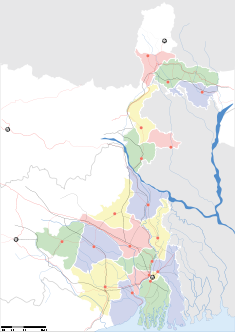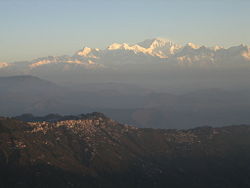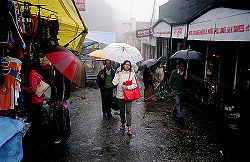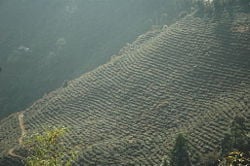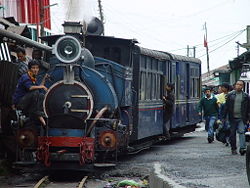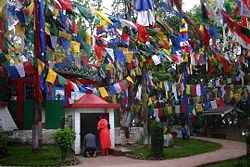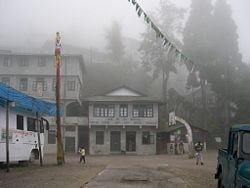Darjeeling
- For other uses, see Darjeeling (disambiguation).
| Darjeeling West Bengal • India | |
| Coordinates: | |
| Time zone | IST (UTC+5:30) |
| Area • Elevation |
10.57 km² (4 sq mi) • 2,134 m (7,001 ft) |
| District(s) | Darjeeling |
| Population • Density |
107,530 (2001) • 8,548 /km² (22,139 /sq mi) |
| Chairman | Subash Ghishing |
| Codes • Pincode • Telephone • Vehicle |
• 734101 • +0354 • WB-73 WB-74 |
Coordinates: Darjeeling (Nepali: दार्जीलिङ्ग , Bengali: দার্জিলিং) is a town in the Indian state of West Bengal. It is the headquarters of Darjeeling district, in the Shiwalik Hills on the lower range of the Himalaya, at an average elevation of 2,134 m (6,982 ft). The name "Darjeeling" is a combination of the Tibetan words Dorje ("thunderbolt") and ling ("place"), translating to "The land of the thunderbolt."[1] During the British Raj in India, Darjeeling's temperate climate led to its development as a hill station (hill town) for British residents to escape the heat of the plains during the summers.
Darjeeling is internationally famous for its tea industry and the Darjeeling Himalayan Railway, a UNESCO World Heritage Site. The tea plantations date back to the mid 19th century as part of a British development of the area. The tea growers of the area developed distinctive hybrids of black tea and fermenting techniques, with many blends considered among the world's finest. The Darjeeling Himalayan Railway connecting the town with the plains was declared a World Heritage Site in 1999 and is one of the few steam engines still in service in India.
Darjeeling has several British-style public schools, which attract students from many parts of India and neighbouring countries. The town, along with neighbouring Kalimpong was a major centre for the demand of a separate Gorkhaland state in the 1980s, though the separatist movement has gradually decreased over the past decade due to the setting up of an autonomous hill council. In the recent years the town's fragile ecology is threatened by a rising demand for environmental resources, stemming from growing tourist traffic and poorly planned urbanisation.
History
The history of Darjeeling is intertwined with that of Nepal, Bhutan, Sikkim and Bengal. Until the early 19th century, the area around Darjeeling was ruled intermittently by the kingdoms of Nepal and Sikkim,[2] with settlement consisting of a few villages of Lepcha woodspeople.[3] In 1828, a delegation of British East India Company officials on their way to Sikkim stayed in Darjeeling and decided that the region was a suitable site for a sanitarium for British soldiers.[4] The Company negotiated a lease of the area from the Chogyal of Sikkim in 1835.[2] Arthur Campbell, a surgeon with the Company and Lieutenant Napier (later Lord Napier of Magdala) were given the responsibility to found a hill station there.
The British established experimental tea plantations in Darjeeling in 1841. The success of these experiments led to the development of tea estates all around the town in the second half of the 19th century.[5] Darjeeling was annexed by the British Indian Empire a few years after an incident of discord between Sikkim and the Company in 1849.[6] During this time immigrants, mainly from Nepal, were recruited to work at construction sites, tea gardens, and on other agriculture-related projects.[4] Scottish missionaries undertook the construction of schools and welfare centres for the British residents, laying the foundation for Darjeeling's high reputation as a centre of education. The opening of the Darjeeling Himalayan Railway in 1881 hastened the development of the region.[7] In 1898, Darjeeling was rocked by a major earthquake (known as the "Darjeeling disaster") that caused severe damage to the town and the native population.[8][9]
Under British rule, the Darjeeling area was initially a "Non-Regulation District" (a scheme of administration applicable to economically less advanced districts in the British Raj[10]) — acts and regulations of the British Raj did not automatically apply to the district in line with rest of the country. As a consequence of the 1905 Partition of Bengal, the area came under the jurisdiction of the Rajshahi division[11] and was placed in the newly created province of East Bengal and Assam. Later in 1919, the area was declared a "backward tract".[10] Darjeeling's elite residents were the British ruling class of the time, who visited Darjeeling every summer. An increasing number of well-to-do Indian residents of Kolkata (then Calcutta), affluent Maharajas of princely states and land-owning zamindars also began visiting Darjeeling.[12] The town continued to grow as a tourist destination, becoming known as the "Queen of the Hills".[13] The town did not see any significant political activity during the freedom struggle of India owing to its remote location and small population. However, there was a failed assassination attempt by revolutionaries on Sir John Anderson, the Governor of Bengal in the 1930s.[11]
After the independence of India in 1947, Darjeeling was merged with the state of West Bengal. The separate district of Darjeeling was established consisting of the hill towns of Darjeeling, Kurseong, Kalimpong and some parts of the Terai region. When the People's Republic of China annexed Tibet in 1950, thousands of Tibetan refugees settled across Darjeeling district. A diverse ethnic population gave rise to socio-economic tensions, and the demand for the creation of the separate states of Gorkhaland and Kamtapur along ethnic lines grew popular in the 1980s. The issues came to a head after a 40-day strike called by the Gorkha National Liberation Front, during which violence gripped the city, causing the state government to call in the Indian Army to restore order. Political tensions largely declined with the establishment of the Darjeeling Gorkha Hill Council under the chairmanship of Subash Gishing. The DGHC was given semi-autonomous powers to govern the district. Later its name was changed to "Darjeeling Gorkha Autonomous Hill Council" (DGAHC). Though Darjeeling is now peaceful, the issue of a separate state still lingers.
Geography
Darjeeling is located at an average elevation of 2,134 m or 6,982 ft[14] in the Darjeeling Himalayan hill region on the Darjeeling-Jalapahar range that originates in the south from Ghum. The range is Y-shaped with the base resting at Katapahar and Jalapahar and two arms diverging north of Observatory Hill. The north-eastern arm dips suddenly and ends in the Lebong spur, while the north-western arm passes through North Point and ends in the valley near Tukver Tea Estate.[2]
Darjeeling is the main town of the Sadar subdivision and also the headquarters of the district. Most of the district, including the town of Darjeeling lies in the Shiwalik Hills (or Lower Himalaya). The soil is chiefly composed of sandstone and conglomerate formations, which are the solidified and upheaved detritus of the great range of Himalaya. However, the soil is often poorly consolidated (the permeable sediments of the region do not retain water between rains) and is not considered suitable for agriculture. The area has steep slopes and loose topsoil, leading to frequent landslides during the monsoons. According to the Bureau of Indian Standards, the town falls under seismic zone-IV, (on a scale of I to V, in order of increasing proneness to earthquakes) near the convergent boundary of the Indian and the Eurasian tectonic plates and is subject to frequent quakes. The hills are nestled within higher peaks and the snow-clad Himalayan ranges tower over the town in the distance. Mount Kanchenjunga (8,591 m or 28,185 ft) — the world's third-highest peak — is the most prominent peak visible. In days clear of clouds, Nepal's Mount Everest (8,850 m or 29,028 ft) can be seen.[15]
There are several tea plantations in the area. The town of Darjeeling and surrounding region face deforestation due to increasing demand for wood fuel and timber, as well as air pollution from increasing vehicular traffic.[16] Flora around Darjeeling includes temperate, deciduous forests of poplar, birch, oak, and elm as well as evergreen, coniferous trees of wet alpine. Dense evergreen forests lie around the town, where a wide variety of rare orchids are found. Lloyd's Botanical Garden preserves common and rare species of flora, while the Padmaja Naidu Himalayan Zoological Park is the only specialised zoo in the country conserving and breeding endangered Himalayan species.[17]
Climate
Darjeeling's temperate climate has five distinct seasons: spring, summer, autumn, winter, and the monsoons. Summers (lasting from May to June) are mild, with maximum temperatures rarely crossing 25 °C (77 °F). The monsoon season from June to September is characterised by intense torrential rains often causing landslides that block Darjeeling's land access to the rest of the country. In winter temperature averages 5–7 °C (41–44 °F). Occasionally the temperatures drop below freezing; snowfalls are rare. During the monsoon and winter seasons, Darjeeling is often shrouded in mist and fog. The annual mean temperature is 12 °C (53 °F); monthly mean temperatures range from 5–17 °C (41–62 °F).[18] The highest temperature ever recorded in the district was 26.7 °C (80.1 °F) on 23 August 1957; the lowest-ever temperature recorded was −5 °C (23 °F) on 11 February 1905.[19] The average annual precipitation is 281.8 cm (110.9 in), with the highest incidence occurring in July (75.3 cm or 29.6 in).[18]
Civic administration
The Darjeeling urban agglomeration consists of Darjeeling Municipality and the Pattabong Tea Garden.[20] Established in 1850, the Darjeeling municipality maintains the civic administration of the town, covering an area of 10.57 km² (4.08 mi²).[20] The municipality consists of a board of councillors elected from each of the 32 wards of Darjeeling town as well as a few members nominated by the state government. The board of councillors elects a chairman from among its elected members;[2] the chairman is the executive head of the municipality. The Gorkha National Liberation Front (GNLF) at present holds power in the municipality. The Gorkha-dominated hill areas of the whole Darjeeling district is under the jurisdiction of the Darjeeling Gorkha Autonomous Hill Council since its formation in 1988. The DGHC's elected councillors are authorised to manage certain affairs of the hills, including education, health and tourism. The town is within the Darjeeling Lok Sabha constituency and elects one member to the Lok Sabha (Lower House) of the Indian Parliament. It elects one member in the West Bengal state legislative assembly, the Vidhan Sabha. The Indian National Congress won the parliamentary election in 2004, while the state assembly seat was won by GNLF in the 2006 polls. Darjeeling town comes under the jurisdiction of the district police (which is a part of the state police); a Deputy Superintendent of Police oversees the town's security and law affairs. Darjeeling municipality area has two police stations at Darjeeling and Jorebungalow.[21]
Utility services
Natural springs provide most of Darjeeling's water supply – water collected is routed to Senchal Lake (10 km or 6.2 miles southeast of town), from where it is piped to the town. During the dry season, when water supplied by springs is insufficient, water is pumped from Khong Khola, a nearby small perennial stream. There is a steadily widening gap between water supply and demand; just over 50% of the town's households are connected to the municipal water supply system.[2] The town has an underground sewage system that collects domestic waste from residences and about fifty community toilets. Waste is then conveyed to six central septic tanks and ultimately disposed of in natural jhoras (waterways); roadside drains also collect sewage and storm water. Municipal Darjeeling produces about 50 tonnes (110,200 lb) of solid waste every day, which is disposed of in nearby disposal sites.[2]
Electricity is supplied by the West Bengal State Electricity Board, and the West Bengal Fire Service provides emergency services for the town. The town often suffers from power outages and the electrical supply voltage is unstable, making voltage stabilisers popular with many households. Almost all of the primary schools are now maintained by Darjeeling Gorkha Autonomous Hill Council. The total length of all types of roads — including stepped paths within the municipality — is around 90 km (56 miles); these are maintained by the municipality.[2]
Economy
The two most significant contributors to Darjeeling's economy are tourism and the tea industry. Darjeeling tea is regarded as the best of black teas and is widely popular,[22] especially in the UK and the countries making up the former British Empire. The tea industry has faced competition in recent years from tea produced in other parts of India as well as other countries like Nepal.[23] Widespread concerns about labour disputes, worker layoffs and closing of estates have affected investment and production.[24] Several tea estates are being run on a workers' cooperative model, while others are being planned for conversion into tourist resorts.[24] More than 60% of workers in the tea gardens are women. The remuneration of workers are often half in cash and half in other benefits like accommodation, subsidised rations, free medical benefits etc.[25]
The district's forests and other natural wealth have been adversely affected by an ever-growing population.[20] The years since independence have seen substantial advances in the area's education, communication and agriculture – the latter including the production of diverse cash crops like potato, cardamom, ginger, and oranges. Farming on terraced slopes is a major source of livelihood for the rural populace around the town and it supplies the town with fruits and vegetables.
Summer and spring seasons are most popular with tourists, keeping many of Darjeeling's residents employed directly and indirectly, with many residents owning and working in hotels and restaurants. Many people earn a living working for tourism companies and as guides. Darjeeling is a popular filming destination for Bollywood and Bengali cinema; films such as Aradhana, Main Hoon Na, Kanchenjungha have been filmed here. As the district headquarters, Darjeeling employs many in government offices. Small contributions to the economy come from the sale of traditional arts and crafts of Sikkim and Tibet.
Transport
The town of Darjeeling can be reached by the 80 km (50 miles) long Darjeeling Himalayan Railway (nicknamed the "Toy Train") from Siliguri, or by the Hill Cart Road (National Highway 55) that follows the railway line. The Darjeeling Himalayan Railway is a 60 cm (2 ft) narrow-gauge railway. It was declared a World Heritage Site by UNESCO in 1999, becoming only the second railway in the world to have this honour.[7] Regular bus services and hired vehicles connect Darjeeling with Siliguri and the neighbouring towns of Kurseong, Kalimpong and Gangtok. Four wheel drives, including Land Rovers, are the most popular means of transport, as they can easily navigate the steep slopes in the region. However, road and rail communications often get disrupted in the monsoons due to landslides. The nearest airport is in Bagdogra near Siliguri, located about 93 km (58 miles) from Darjeeling. Indian Airlines, Jet Airways and Air Deccan are the three major carriers that connect the area to Delhi, Kolkata and Guwahati. The closest major railway station is in New Jalpaiguri, which is connected with almost all major cities of the country. Within the town, people usually traverse by walking. Residents also use bicycle, two-wheelers and hired taxis for travelling short distances. The Darjeeling Ropeway, functional from 1968 to 2003, was stopped after an accident killed four tourists.[26][27]
Demographics
As per the 2001 census, the Darjeeling urban agglomeration (which includes Pattabong Tea Garden), with an area of 12.77 km² (4.93 mi²) has a population of 109,163, while the municipal area has a population of 107,530.[20] The town has an additional average diurnal floating population of 20,500 – 30,000, mainly consisting of the tourists.[2] The population density of the municipal area is 10,173 per km².[20] The sex ratio is 1,017 females per 1,000 males[20] — which is higher than the national average. The women make a significant contribution as earning members of households and the workforce. The town houses approximately 31% of its population in the slums and shanty buildings — a consequence of heavy immigration.[2] The major religion is Hinduism, followed by Buddhism. Christians and Muslims form sizable minorities.[28] The population's ethnic composition is closely linked with that of Bhutan, Nepal, Sikkim and Bengal. The majority of the populace is of ethnic Nepali background, having migrated to Darjeeling in search of jobs during the British rule. Indigenous ethnic groups include the Lepchas, Bhutias, Sherpas, Rais, Yamloos, Damais, Kamais, Newars and Limbus. Other communities that inhabit Darjeeling include the Bengalis, Marwaris, Anglo-Indians, Chinese, Biharis and Tibetans. The most commonly spoken language is Nepali (Gorkhali); Hindi, Bengali and English are also used.
Darjeeling has seen significant growth in its population during the last century, especially since the 1970s. Annual growth rates reached as high as 45% in the 1990s, far above the national, state, and district averages.[2] The colonial town had been designed for a mere population of 10,000, and subsequent growth has created extensive infrastructual and environmental problems. The region is relatively new in geological terms and unstable in nature, suffering from a host of environmental problems.[2] Environmental degradation, including denudation of the surrounding hills has adversely affected Darjeeling's appeal as a tourist destination.[16]
Culture
Apart from the major religious festivals of Diwali, Christmas, Dussera, Holi etc., the diverse ethnic populace of the town celebrates several local festivals. The Lepchas and Bhutias celebrate new year in January, while Tibetans celebrate the new year (Losar) with "Devil Dance" in February–March. The Maghe sankranti, Ram Navami, Chotrul Duchen, Buddha Jayanti, the birthday of the Dalai Lama and Tendong Lho Rumfaat are some other festivals, some distinct to local culture and others shared with the rest of India, Nepal, Bhutan and Tibet. Darjeeling Carnival, initiated by a civil society movement known as The Darjeeling Initiative, is a ten day carnival held every year during the winter with the high quality portrayal of the rich musical and cultural heritage of Darjeeling Hills as its central theme.[29]
A popular food in Darjeeling is the momo, a steamed dumpling containing pork, beef and vegetables cooked in a doughy wrapping and served with watery soup. Wai-Wai is a packaged snack consisting of noodles which are eaten either dry or in soup form. Churpee, a kind of hard cheese made from cow's or yak's milk is sometimes chewed. A form of noodle called thukpa, served in soup form is also popular in Darjeeling. There are a large number of restaurants which offer a wide variety of traditional Indian, continental and Chinese cuisines to cater to the tourists. Tea is the most popular beverage, procured from the famed Darjeeling tea gardens, as well as coffee. Chhang is a local beer made from millet.
Colonial architecture characterises many buildings in Darjeeling; several mock Tudor residences, Gothic churches, the Raj Bhawan (Governor House), Planters' Club and various educational institutions are examples. Buddhist monasteries showcase the pagoda style architecture. Darjeeling is regarded as a centre of music and a niche for musicians and music admirers. Singing and playing musical instruments is a common pastime among the resident population, who take pride in the traditions and role of music in cultural life.[30] Western music is popular among the younger generation, and Darjeeling is a major centre of Nepali rock music. Cricket and football are the most popular sports in Darjeeling. An improvised form of ball made of rubber garters (called chungi) is often used for playing in the steep streets.
Some notable places to visit include the Tiger Hill, the zoo, monasteries and the tea gardens. The town attracts trekkers and sportsmen seeking to explore the Himalayas, serving as the starting point for climbing attempts on some Indian and Nepali peaks. Tenzing Norgay, one of the two men to first climb Mount Everest, spent most of his adult life in the Sherpa community in Darjeeling. His success provided the impetus to establish the Himalayan Mountaineering Institute in Darjeeling in 1954. In the Tibetan Refugee Self Help Center, Tibetan crafts like carpets, wood and leather work are displayed. Several monasteries like Ghum Monastery (8 km or 5 miles from the town), Bhutia Busty monastery, Mag-Dhog Yolmowa preserve ancient Buddhist scripts.
Education
Darjeeling's schools are either run by the state government or by private and religious organisations. Schools mainly use English and Nepali as their medium of instruction, although the national language Hindi and the official state language Bengali are also stressed. The schools are either affiliated with the ICSE, the CBSE, or the West Bengal Board of Secondary Education. Having been a summer retreat for the British in India, Darjeeling soon became the place of choice for the establishment of public schools on the model of Eton, Harrow and Rugby, allowing the children of British officials to obtain an exclusive education.[31] Institutions such as St. Joseph's College (School Dept.), Loreto Convent, St. Paul's School and Mount Hermon School attract students from all over India and South Asia. Many schools (some are more than a hundred years old) still adhere to the traditions from its British and colonial heritage. Darjeeling hosts three colleges — St. Joseph's College, Loreto College and Darjeeling Government College — all affiliated to University of North Bengal in Siliguri.
Media
Newspapers in Darjeeling include English language dailies, The Statesman and The Telegraph, which are printed in Siliguri, and The Hindustan Times and the Times of India which are printed in Kolkata and are received after a day's delay. In addition to these one can also find Nepali, Hindi and Bengali publications. Nepali newspapers include "Sunchari," "Himali Darpan". The public radio station, All India Radio is the only one that can be received in Darjeeling. However, Darjeeling receives almost all the television channels that are received by the rest of the country. Apart from the state-owned terrestrial network Doordarshan, cable television serves most of the homes in the town, while satellite television is common in the outlying areas and in wealthier households. Besides mainstream Indian channels, the town also receives local Nepali language channels. Internet cafés are well established in the main market area, served through dial-up access. BSNL provides a limited form of broadband connectivity of up to 128 kbit/s with DIAS (Direct Internet Access System) connections. The area is serviced by local cellular companies such as BSNL, Reliance Infocomm, Hutch and Airtel.
See also
| |||||||||||||||||
| |||||||||||
Notes
- ↑ Eastern Himalayas DARJEELING : The Queen of Hills. Neptune Tours & Travels. Retrieved 2006-05-01.
- ↑ 2.00 2.01 2.02 2.03 2.04 2.05 2.06 2.07 2.08 2.09 2.10 Khawas, Vimal (2003). Urban Management in Darjeeling Himalaya: A Case Study of Darjeeling Municipality.. The Mountain Forum. Retrieved 2006-05-01. Now available in the Internet Archive in this URL (accessed on 7 June 2006)
- ↑ Darjeeling Tea. h2g2, BBC (2005-05-12). Retrieved 2006-08-17.
- ↑ 4.0 4.1 History of Darjeeling. darjnet.com. Retrieved 2006-08-17.
- ↑ Darjeeling Tea History. Darjeelingnews. Retrieved 2006-05-02.
- ↑ Cite error: Invalid
<ref>tag; no text was provided for refs namedHistory2 - ↑ 7.0 7.1 Mountain Railways of India. UNESCO World Heritage Centre. Retrieved 2006-04-30.
- ↑ A Pride of Panners (PDF Format) pp. 43. Baron Courts of Prestoungrange & Dolphinstoun. Retrieved 2006-04-30.
- ↑ (Lee 1971)
- ↑ 10.0 10.1 Chakraborty, Subhas Ranjan (2003). Autonomy for Darjeeling: History and Practice. Experiences on Autonomy in East and North East: A Report on the Third Civil Society Dialogue on Human Rights and Peace (By Sanjoy Borbara). Mahanirban Calcutta Research Group. Retrieved 2006-08-13.
- ↑ 11.0 11.1 History of Darjeeling. exploredarjeeling.com. Retrieved 2006-05-02.
- ↑ Shringla, T.T. (2003). Travelogues: Toy Train to Darjeeling. India Travelogue. Retrieved 2006-06-08.
- ↑ Chattopadhyay, S.S. (January 2005). Return of the queen. Frontline 22 (01).
- ↑ GeneralInformation. zubin.com. Retrieved 2006-04-30.
- ↑ Darjeeling. Encyclopædia Britannica. Encyclopædia Britannica Premium Service. Retrieved 2006-07-26.
- ↑ 16.0 16.1 TERI (2001). Sustainable Development in the Darjeeling Hill Area (PDF) pp. 20. Tata Energy Research Institute, New Delhi. (TERI Project No.2000UT64). Retrieved 2006-05-01.
- ↑ Padmaja Naidu Himalayan Zoological Park. Darjeelingnews.net. Retrieved 2006-05-04.
- ↑ 18.0 18.1 Weatherbase entry for Darjeeling. Canty and Associates LLC. Retrieved 2006-04-30.
- ↑ geography. darjeelingnews.net. Retrieved 2006-04-30.
- ↑ 20.0 20.1 20.2 20.3 20.4 20.5 Directorate of Census Operations, West Bengal (2003). Table-4 Population, Decadal Growth Rate, Density and General Sex Ratio by Residence and Sex, West Bengal/ District/ Sub District, 1991 and 2001. Retrieved 2006-04-30.
- ↑ Directorate of Census Operations, West Bengal (2003). Table-3 District Wise List of Statutory Towns ( Municipal Corporation, Municipality, Notified Area and Cantonment Board), Census Towns and Outgrowths, West Bengal, 2001. Retrieved 2006-04-30.
- ↑ Cite error: Invalid
<ref>tag; no text was provided for refs namedteabest - ↑ "Darjeeling tea growers at risk", BBC News, 27 July 2001. Retrieved 2006-05-08.
- ↑ 24.0 24.1 Haber, Daniel B, "Economy-India: Famed Darjeeling Tea Growers Eye Tourism for Survival", Inter Press Service News Agency, 14 January 2004. Retrieved 2006-05-08.
- ↑ "Darjeeling Tea Facts", Darjeelingmews.net. Retrieved 2006-05-08.
- ↑ Darjeeling ropeway mishap kills four. Page One. The Statesman (20 October 2003). Retrieved 2007-06-30.
- ↑ Mookerjee, Soma (22 June 2007). Darjeeling Ropeway to open again. Bengal. The Statesman. Retrieved 2007-06-30.
- ↑ Darjeeling Festivals. darjeelingnews.net. Retrieved 2006-05-01.
- ↑ Chattopadhyay, S.S. (December 2003). The spirit of Darjeeling. Frontline 20 (25).
- ↑ Rasaily DP, Lama RP. The Nature-centric Culture of the Nepalese. The Cultural Dimension of Ecology. Indira Gandhi National Centre for the Arts, New Delhi. Retrieved 2006-07-31.
- ↑ Lal, Vinay. "Hill Stations: Pinnacles of the Raj." Review article on Dale Kennedy, The Magic Mountains : Hill Stations and the British Raj. UCLA Social Sciences Computing. Retrieved 2001-07-30.
ReferencesISBN links support NWE through referral fees
- Bradnock, R & Bradnock, R (2004), Footprint India Handbook (13th ed.), Footprint Handbooks, ISBN 1904777007
- Brown, Percy (1917), Tours in Sikhim and the Darjeeling District (3rd (1934) ed.), Calcutta: W. Newman & Co., ISBN ASIN: B0008B2MIY
- Kennedy, Dane (1996), Magic Mountains: Hill Stations and the British Raj, University of California Press, ISBN 0520201884
- Lee, Ada (1971), The Darjeeling disaster: Triumph through sorrow : the triumph of the six Lee children, Lee Memorial Mission, ISBN ASIN: B0007AUX00
- … (1900), Newman's Guide to Darjeeling and Its Surroundings, Historical & Descriptive, with Some Account of the Manners and Customs of the Neighbouring Hill Tribes, and a Chapter on Thibet and the Thibetans, W. Newman and Co.
- Saraswati, Baidyanath (Ed) (1998), Cultural Dimension of Ecology, DK Print World Pvt.Ltd, India, ISBN 812460102X
- Ronaldshay, The Earl of (1923), Lands of the Thunderbolt. Sikhim, Chumbi & Bhutan, London: Constable & Co., ISBN 81-206-1504-2 (Reprint)
- Singh, S (2005), Lonely Planet India (11th ed.), Lonely Planet Publications, ISBN 1740596943
- Waddell, L.A. (2004), Among the Himalayas, Kessinger Publishing, ISBN 076618918X
- Roy, Barun (2003), Fallen Cicada (2003 ed.), Beacon Publication, ISBN 0732193121X
External links
| This article contains Indic text. Without proper rendering support, you may see question marks or boxes, misplaced vowels or missing conjuncts instead of Indic text. |
- {{{2}}} at the Open Directory Project
- Travel guide to Darjeeling from Wikitravel
| |||||||||||
Credits
New World Encyclopedia writers and editors rewrote and completed the Wikipedia article in accordance with New World Encyclopedia standards. This article abides by terms of the Creative Commons CC-by-sa 3.0 License (CC-by-sa), which may be used and disseminated with proper attribution. Credit is due under the terms of this license that can reference both the New World Encyclopedia contributors and the selfless volunteer contributors of the Wikimedia Foundation. To cite this article click here for a list of acceptable citing formats.The history of earlier contributions by wikipedians is accessible to researchers here:
The history of this article since it was imported to New World Encyclopedia:
Note: Some restrictions may apply to use of individual images which are separately licensed.

